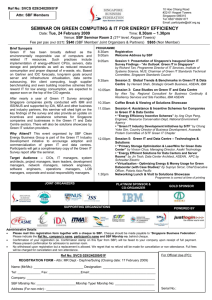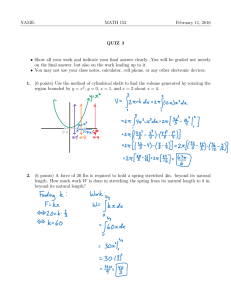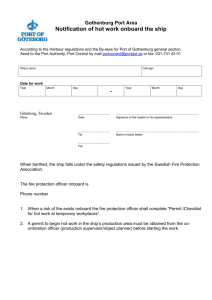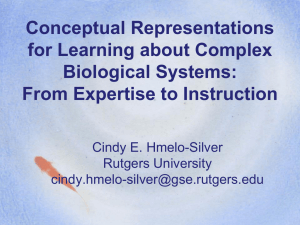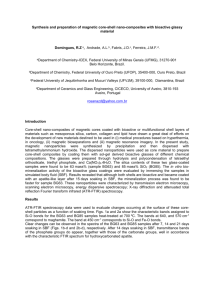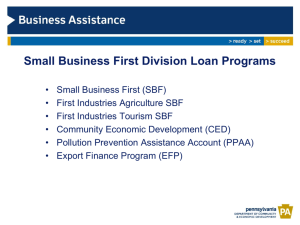Document 14538469
advertisement
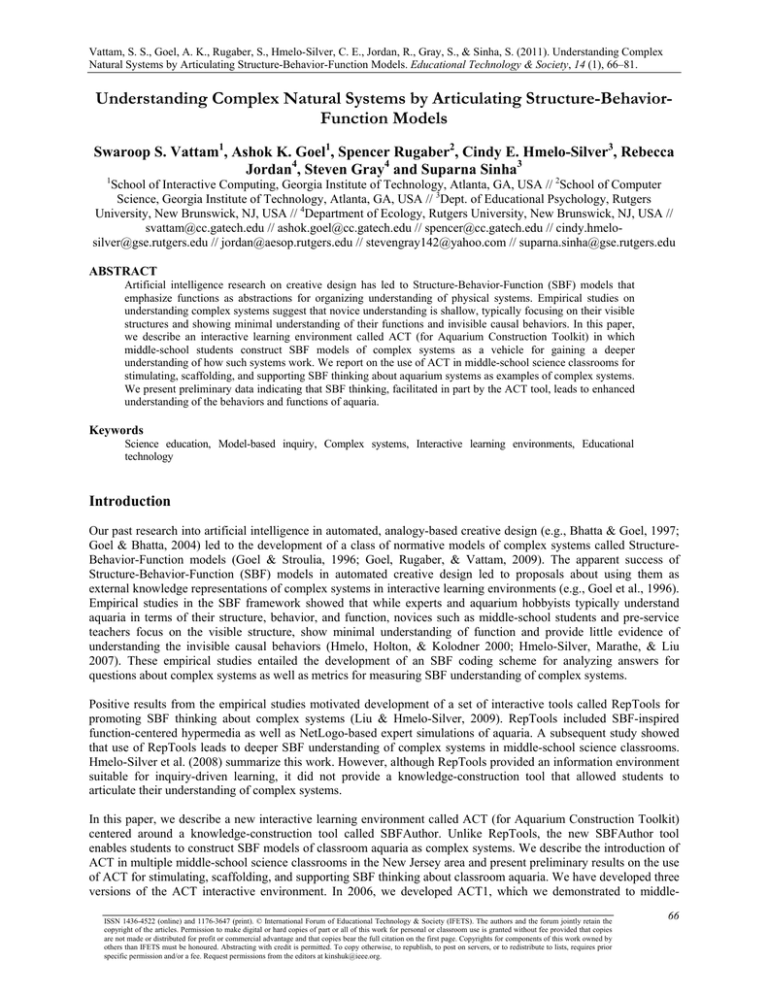
Vattam, S. S., Goel, A. K., Rugaber, S., Hmelo-Silver, C. E., Jordan, R., Gray, S., & Sinha, S. (2011). Understanding Complex Natural Systems by Articulating Structure-Behavior-Function Models. Educational Technology & Society, 14 (1), 66–81. Understanding Complex Natural Systems by Articulating Structure-BehaviorFunction Models Swaroop S. Vattam1, Ashok K. Goel1, Spencer Rugaber2, Cindy E. Hmelo-Silver3, Rebecca Jordan4, Steven Gray4 and Suparna Sinha3 1 School of Interactive Computing, Georgia Institute of Technology, Atlanta, GA, USA // 2School of Computer Science, Georgia Institute of Technology, Atlanta, GA, USA // 3Dept. of Educational Psychology, Rutgers University, New Brunswick, NJ, USA // 4Department of Ecology, Rutgers University, New Brunswick, NJ, USA // svattam@cc.gatech.edu // ashok.goel@cc.gatech.edu // spencer@cc.gatech.edu // cindy.hmelosilver@gse.rutgers.edu // jordan@aesop.rutgers.edu // stevengray142@yahoo.com // suparna.sinha@gse.rutgers.edu ABSTRACT Artificial intelligence research on creative design has led to Structure-Behavior-Function (SBF) models that emphasize functions as abstractions for organizing understanding of physical systems. Empirical studies on understanding complex systems suggest that novice understanding is shallow, typically focusing on their visible structures and showing minimal understanding of their functions and invisible causal behaviors. In this paper, we describe an interactive learning environment called ACT (for Aquarium Construction Toolkit) in which middle-school students construct SBF models of complex systems as a vehicle for gaining a deeper understanding of how such systems work. We report on the use of ACT in middle-school science classrooms for stimulating, scaffolding, and supporting SBF thinking about aquarium systems as examples of complex systems. We present preliminary data indicating that SBF thinking, facilitated in part by the ACT tool, leads to enhanced understanding of the behaviors and functions of aquaria. Keywords Science education, Model-based inquiry, Complex systems, Interactive learning environments, Educational technology Introduction Our past research into artificial intelligence in automated, analogy-based creative design (e.g., Bhatta & Goel, 1997; Goel & Bhatta, 2004) led to the development of a class of normative models of complex systems called StructureBehavior-Function models (Goel & Stroulia, 1996; Goel, Rugaber, & Vattam, 2009). The apparent success of Structure-Behavior-Function (SBF) models in automated creative design led to proposals about using them as external knowledge representations of complex systems in interactive learning environments (e.g., Goel et al., 1996). Empirical studies in the SBF framework showed that while experts and aquarium hobbyists typically understand aquaria in terms of their structure, behavior, and function, novices such as middle-school students and pre-service teachers focus on the visible structure, show minimal understanding of function and provide little evidence of understanding the invisible causal behaviors (Hmelo, Holton, & Kolodner 2000; Hmelo-Silver, Marathe, & Liu 2007). These empirical studies entailed the development of an SBF coding scheme for analyzing answers for questions about complex systems as well as metrics for measuring SBF understanding of complex systems. Positive results from the empirical studies motivated development of a set of interactive tools called RepTools for promoting SBF thinking about complex systems (Liu & Hmelo-Silver, 2009). RepTools included SBF-inspired function-centered hypermedia as well as NetLogo-based expert simulations of aquaria. A subsequent study showed that use of RepTools leads to deeper SBF understanding of complex systems in middle-school science classrooms. Hmelo-Silver et al. (2008) summarize this work. However, although RepTools provided an information environment suitable for inquiry-driven learning, it did not provide a knowledge-construction tool that allowed students to articulate their understanding of complex systems. In this paper, we describe a new interactive learning environment called ACT (for Aquarium Construction Toolkit) centered around a knowledge-construction tool called SBFAuthor. Unlike RepTools, the new SBFAuthor tool enables students to construct SBF models of classroom aquaria as complex systems. We describe the introduction of ACT in multiple middle-school science classrooms in the New Jersey area and present preliminary results on the use of ACT for stimulating, scaffolding, and supporting SBF thinking about classroom aquaria. We have developed three versions of the ACT interactive environment. In 2006, we developed ACT1, which we demonstrated to middleISSN 1436-4522 (online) and 1176-3647 (print). © International Forum of Educational Technology & Society (IFETS). The authors and the forum jointly retain the copyright of the articles. Permission to make digital or hard copies of part or all of this work for personal or classroom use is granted without fee provided that copies are not made or distributed for profit or commercial advantage and that copies bear the full citation on the first page. Copyrights for components of this work owned by others than IFETS must be honoured. Abstracting with credit is permitted. To copy otherwise, to republish, to post on servers, or to redistribute to lists, requires prior specific permission and/or a fee. Request permissions from the editors at kinshuk@ieee.org. 66 school teachers but did not introduce in any classroom. In 2007, we developed ACT2 based in part on feedback from middle-school teachers on ACT1. In early 2008, we introduced ACT2 into three middle-school classrooms in central New Jersey. Later in 2008, we developed ACT3 based in part on feedback from middle-school students and teachers on ACT2. In 2009, we introduced ACT3 in multiple middle-school classrooms in central New Jersey. We are still analyzing data from ACT3. In this paper we describe the design and development of ACT2 and the data collected from its use of middle-school science classes in 2008. Educational background and context The design of the ACT learning environment has been influenced by several areas of scholarship, which we briefly summarize below. Complex systems ACT was designed to help students understand complex systems such as aquaria. Narayanan (2007) characterizes complex systems as follows: 1. Complex systems exhibit hierarchical structures composed of subsystems and components. 2. Subsystems and components exhibit natural behaviors or engineered functions. 3. The subsystem/component behaviors causally influence other subsystems/components. 4. The propagation of these causal influences creates chains of events in the operation of the overall system and gives rise to its overall behavior and function. 5. These chains of events extend in temporal and spatial dimensions. In complex systems, invisible causal processes occur at many levels of abstraction, with a causal process at one level emerging out of interactions among components at a lower level (Chi, 2005). Since complex systems are all around us, in nature as well as in society, the study of complex systems has been recognized as a key idea in science education in national science standards (National Research Council, 1996) as well as state and local standards (e.g., New Jersey Department of Education, 2006). Aquaria as complex systems in ecological science For the ACT project, we selected fish-aquarium systems as the context in which middle-school students would learn about complex systems. This context was motivated in part by a growing focus on earth systems education that necessitates an understanding of coupled earth and ecological systems (National Research Council, 1996). Given recent environmental stresses on the global community, ecosystem understanding is fast becoming a requisite for informed decision-making as citizens (Jordan, Singer, Vaughn, & Berkowitz, 2008). Further, the complex yet accessible nature of aquaria appeals to middle-school teachers seeking to incorporate model-based investigation with big ideas relating to ecosystems (e.g., Hmelo-Silver et al., 2008; Stansbury, 1999). The general familiarity with aquaria paired with the need to know often provides a motivating context for middle-school students to interact with this complex system. Finally, the themes highlighted by studying aquaria are aligned with the material and skills taught in many middle-school science classrooms. Because of this alignment in content and desired skill base, teachers can use aquarium systems to provide students with the opportunity to abstract and contextualize ideas at multiple levels of iterative complexity. Design of aquaria as a context for learning about complex systems ACT is intended to support design (i.e., the establishment and maintenance) of classroom aquaria. The notions of functions and causal behaviors that accomplish them are central to designing. Establishing and maintaining an aquarium system requires an understanding of biological, chemical, and physical properties and processes (Dawes, 2000; Stadelmann, Finley, & Vriends, 2003; Stansbury, 1999). Thus, the task of establishment and maintenance of a classroom aquarium should support deep understanding of causality and functionality at many levels of abstraction. However, without scaffolding, students may focus on completing the task rather than on understanding how the 67 system works. Puntambekar & Kolodner (2005) have shown that without support, children engaging in design activity may fail to focus on the underlying science. Functional models of complex systems The origin of our SBF models of complex systems lies in Chandrasekaran’s (1994) Functional Representation (FR) scheme. Goel, Rugaber, & Vattam (2009) describe in detail how the SBF modeling language evolved from the FR scheme. Other researchers have developed similar formally specified functional models of complex systems for use in creative design. For example, Kitamura, Sano, Namba, & Mizoguchi (2002) describe the use of their ontology of functions for systematization of functional knowledge of complex systems. Erden et al. (2008) survey conceptual schemes for functional modeling of complex systems and their use in creative design. Although various schemes for functional modeling differ in many features, they all share some key characteristics, for example, the centrality of function in organizing knowledge of complex systems, a view of behavior as an intermediate abstraction between structure and function, and the importance of ontologies for representing functions and behaviors. This is in contrast to traditional general-purpose declarative models such as concepts maps (Novak & Gowin, 1984). While concept maps enable the construction of arbitrarily complex models (Krajcik, Czerniak, & Berger, 1999), the complexity and vagueness of concept maps makes critiquing hard (Marzano, Pickering, & Polluck, 2001). Functional modeling also contrasts with qualitative modeling and simulation tools such as Model-It (Metcalf, Krajcik, & Soloway, 2000) and SIMQUEST (van Joolingen & de Jong, 2003). These tools first convert parametric values and relationships entered by a user into a set of qualitative equations, then, given a set of initial conditions, they solve the qualitative equations to produce temporally evolving values of variables. SBF models are a specialized class of declarative models that have unique affordances for representing complex systems such as functional representation, causal explanation, and hierarchical organization. Learning by constructing, critiquing, & revising models Socio-cultural theories of learning suggest engaging learners in the knowledge-building practices of scientists (e.g., Edelson, 1997). Modeling, that is, model construction, critiquing, and revision, is central to scientific inquiry (Darden, 2006; Nersessian, 2008). Scientists build models of complex systems both to improve their understanding and to make predictions. Clement (2008) has argued that learning in science is fundamentally a process of model construction, critiquing and revision. Kreutzer (1986) believed that “the purpose of a model lies in the act of its construction and exploration and in the resultant, improved intuition about the system’s behavior, essential aspects and sensitivities (p. 7).” Further, models can help students understand multiple levels of organization in complex systems (Buckley, 2000). External representations of models From a constructivist perspective, learning entails active construction of knowledge. Increasingly, there is an emphasis on learning through collaborative construction of external representations (Kozma, 2000; Lajoie, Lavigne, Guerrera, & Munsie, 2001; Papert, 1991; Suthers, 2006). Thus, ACT provides interactive tools for external articulation and representation of SBF models of complex systems. The social and cognitive roles of external representations in learning, particularly collaborative learning, have received significant attention as a research focus (e.g., Koedinger & Nathan, 2004; Smolensky, Fox, King, & Lewis, 1987; Suthers et al., 2001). Graesser, VanLehn, Rose, Jordan, & Harter (2001) and Bredeweg & Forbus (2003) describe interactive tools for constructing external representations of causal models. Betty’s Brain (Biswas, Leelawong, Schwartz, & Vye, 2005) is an interesting example of articulation of causal models because it enables students to act as teachers. Visual SBF language In order to adapt the SBF modeling language to serve as an effective scheme for learners, we augmented it with a visual syntax to obtain vSBF, a visual SBF modeling language. Developing an SBF model of a complex system in vSBF now becomes an exercise in drawing an annotated diagram of the system using the modeling primitives 68 provided by the language. The diagrammatic representation of the modeled system is an external representation that serves as stimulus, coordinator, and guide for various learning interactions. Our goal in developing the vSBF syntax was to empower learners with the unique affordances of the SBF language in order to help them understand not only the specifics of particular systems they model but also the meta-level concepts related to complex systems. For example, SBFAuthor supports functional representation and causal explanation of behaviors as described below. (Note, however, that although SBF models in general are organized in a F o B o F o B … F(S) system-subsystem hierarchy, and though a user may use SBFAuthor to model any system or subsystem, SBFAuthor at present does not directly support hierarchical organization of system-subsystem models.) vSBF was developed under the assumption that a visual representation language (augmented with suitable scaffolding) can help students learn these concepts of complex systems provided that (a) the language is capable of capturing all of the said concepts and (b) students express their understanding in the language. Guided by these two assumptions, vSBF contains a palette of visual primitives corresponding to the elements of SBF ontology. Figure 1 captures a sample of the correspondence between the elements of the SBF scheme and their visual counterparts. Figure 1. Elements of vSBF language Figure 2. A snapshot of SBFAuthor’s main interface 69 Interactive construction of SBF models SBFAuthor is an editor for building partial SBF models using vSBF. SBFAuthor partitions an SBF model into three views: structure view, behavior view, and function view, as shown in Figure 2. This figure depicts part of the SBF model of an aquarium. One of the primary functions of a fish tank is to maintain a healthy fish population. Fish release nitrogenous waste products that break down into ammonia. Ammonia, which is highly toxic to most fish, can be removed from a fish tank through nitrification process. Nitrification is the biological process that converts ammonia into other relatively harmless nitrogen compounds. Several species of bacteria are involved in performing this conversion. Some species (such as Nitrosomonas) convert ammonia into nitrite, while others (such as Nitrobacter) convert nitrite into nitrate, which is less toxic than ammonia. Structure view The structure view enables users to create the structure portion of an SBF model in terms of its components, substances, and their associated connections. The structure model is presented as a graph. For each component or substance in the structure, a corresponding node is created. The connections are represented as labeled links between nodes. Figure 3(a) shows the structure view of the aquarium. It consists of component nodes such as “fish,” “plants,” “food,” and “water,” and bacteria such as “Nitrosomonas” and “Nitrobacter.” It also contains substance nodes such as “ammonia,” “nitrite,” “nitrate,” etc. Links between these nodes indicate specific kinds of connections such as “contains,” “inside,” “permeates,” etc. As shown in Figure 3(b), components and substances can be described using dialog boxes in terms of their properties (e.g., “concentration” and “toxicity” are properties associated with “ammonia”). According to the SBF specification, a component can itself comprise a subsystem with its own SBF model. In such situations users can create a separate SBF model for that component and include a reference to the function of the child model in the parent model. Figure 3. Structure view: (a) a structure model of an aquarium, (b) a substance dialog box 70 Behavior view The behavior view enables users to create the behavior model portion of an SBF model by allowing them to create one or more behaviors, which appear as different tabs in the behavior view. Each behavior is represented as a statetransition graph like the one shown in Figure 4(a). For each such behavior, users can create states and transitions. A state is like a snapshot of the complex system in time. A state describes the properties, values, and connections of the structural elements of a system at a given moment. Every state is associated with a dialog box that allows the user to model state variables and their values by choosing them from a list of properties derived from the structure model. For example, Figure 4(a) depicts several states comprising a behavior: “State 1,” where the concentrations of various substances are zero, (Figure 4(b) partially shows this state expanded); “State 2,” where the concentration of ammonia is high; “State 3,” where the concentration of nitrites is high and the concentration of nitrates is low; and “State 4,” where concentration of nitrates is high but that of nitrites is low. A transition is a unidirectional arrow that links two states that are causally connected. For each state change there must be some reason for that change, an explanation for why and how the system changed from one state to another. Annotations on transitions capture the reasons for, or causal explanations for, changes, between states. For instance, in Figure 4(c) the transition between “State 1” and “State 2” contains a reference to the function “Fish PRODUCE Ammonia,” which explains why the concentration of ammonia rose from zero to high as a result of fish activity. Similarly, the transition between “State 2” and “State 3” contains reference to the function “Nitrosomonas CONVERT Ammonia to Nitrites” as an explanation for the increase in the nitrite concentration and decrease in ammonia concentration. Finally, a reference to the function “Nitrobacter CONVERT Nitrites to Nitrates” in the transition between “State 3” and “State 4” explains the increase in nitrates and decrease in nitrites. Figure 4. Behavior view: (a) a specific behavior, (b) state dialog box, (c) transition dialog box 71 Function view The function view enables users to create the function model portion of an SBF model of a system. A function model has one or more functions that appear on different tabs in the function view. For each function, users can state its type (primitive or non-primitive). If the function being modeled is a primitive function, the user can choose from an existing set of primitive functions that are provided by the system. If it is a non-primitive function, the user has to define the new function and include a reference to a behavior that accomplishes it. In Figure 5, for example, the function “maintain healthy fish” is accomplished by the behavior “nitrogen cycle process.” In addition to a reference to the behavior, a user has to specify a pre-state (shown as “initial state” in Figure 5) and a post-state (shown as “desired state” in Figure 5) associated with that function, which represent the necessary states of the system before and after the function is accomplished. In the function view, users can also include a reference to an external stimulus that initiates that function. Figure 5. The function view Figure 6. RepTools contains (a) a function-centered hypermedia, expert simulations of (b) fish spawning, (c) nitrification process 72 Other tools in the ACT learning environment In addition to SBFAuthor, the ACT environment consists of two other major functional units: (1) RepTools are a set of domain-specific (aquaria, in this case) digital tools developed earlier (Hmelo-Silver, Liu, Gray, Finkelstein, & Schwartz, 2007, Liu & Hmelo-Silver, 2009). (2) SBF-NetLogo Simulator allows learners to simulate their SBF models on the NetLogo simulation platform (Wilensky & Resnick 1999). RepTools The ACT environment embeds RepTools within it. RepTools was designed to accompany a physical aquarium installed in each classroom. The kit provides digital tools that feature a function-centered hypermedia from which students can read about the structures, behaviors, and functions occurring within an aquarium system. It also includes micro- and macro-level NetLogo-based simulation developed by experts. The macro-level simulation enables students to test ideas about fish spawning and water quality, and the micro-level simulates the nitrification process that occurs within an aquarium as part of its biological filtration. In combination, these digital tools allow students to gain insight into the explanations behind the processes and outcomes that occur at multiple levels within the aquarium. Figure 6 provides snapshots of this suite of tools. SBFAuthor-NetLogo Simulator The benefits of coupling modeling and simulation are well known (e.g., Feurzeig & Roberts 1999): Students can (1) visualize the behavior of the system they modeled, (2) get feedback about their models by comparing the behavior of the system they modeled with either an expert’s simulation or a real-life version of the system, and (3) get feedback at intermediate stages of their model development. For these reasons, we integrated SBFAuthor with the NetLogo platform (Wilensky 1999; Wilensky & Resnick 1999). Figure 7 illustrates the coupling of an SBF model of an aquarium, given as a declarative conceptual representation (Figure 7a), with NetLogo to produce an agent-based simulation of the model in the form of a graphical animation (Figure 7b). Although SBF models are declarative conceptual representations and NetLogo simulations are agent-based and stochastic, we chose to couple SBFAuthor with NetLogo because of the latter’s use in the extant RepTools. We thought this integration would allow students to compare simulations of the SBF models they construct with the expert simulations in RepTools. However, in the empirical study reported here the students did not make use of this coupling. Instead, in this study, the students used only the NetLogo simulations available as part of RepTools. Thus, in this paper we do not describe integration of SBFAuthor and the NetLogo simulation platform in detail; see Vattam et al., 2009 for more details. Figure 7: (a) Sample SBF model, (b) corresponding simulation in NetLogo 73 ACT in the classroom We now describe the use of the ACT learning environment in a curricular unit on ecological systems in three public middle schools in New Jersey. We focus on pre- and post-test results of 157 middle-school students in the course of this unit. The students were either seventh-grade life-science students or eighth-grade physical-science students. The study was conducted as part of the students’ science instruction. Prior to the intervention, none of the classrooms had aquaria, and SBF had not been taught. In all classroom settings, the teachers used the SBFAuthor and RepTools in the ACT environment to help students learn about the aquarium ecosystem. Prior to the study, all classrooms had a physical aquarium placed in the classroom. Students used the interactive tools on laptops while working in small groups, which varied from two to six students per computer, to generate fifty models. All teachers attended an evening workshop where they were introduced to these interactive tools prior to deployment in the classroom. Teacher A’s class had 32 students, Teacher B’s class had 70 students, and Teacher C’s class had 55 students. Although members of our research team were in each classroom for the duration of the project for data collection and to provide technical support, teachers were not directed in any manner beyond instruction in the SBF modeling scheme, key science concepts and how to use the tools. This freedom allowed teachers to incorporate the tools in manners they saw as appropriate and presumably in ways that complemented their pedagogical styles. Teacher A: Teacher A began with a discussion of SBF modeling and how it can help in reasoning about complex systems. She then introduced the classroom aquarium as a complex system. Students then had the opportunity to read through the function-centered hypermedia. Next students worked first with the macro-level fish spawn simulation and then with the micro-level nitrification process simulation. Following this, students were instructed to generate a model of the nitrification process based on the simulations they had run and through consultation with the hypermedia. Teacher B: Teacher B began with a discussion of SBF modeling and then had students use the SBF scheme as a means to model the aquarium installed in the classroom. Students were encouraged to read the hypermedia then generate an initial model. Following this, students were able to explore the expert-developed simulations. Once completed, students refined their models and incorporated new knowledge as they collected it through self-guided inquiry. Teacher C: Teacher C began with a discussion of the aquarium and used it as a context to introduce SBF modeling. Students were immediately able to read through the hypermedia and answered a series of guiding questions provided on a worksheet. Students also had worksheets on which questions about the macro-level and then the micro-level simulations were provided. Students completed these tasks immediately after working through the hypermedia. From there, students were asked to model the entire aquarium system. Activity Introduction Purpose models of Content models of Table 1. Variation in implementation of the curriculum by Teachers A, B, & C Teacher A Teacher B Teacher C Introduced the concept of Introduced the concept of Used the class aquarium as SBF modeling and then SBF modeling and then the context for introducing used the ACT tool to used the ACT tool to the SBF modeling scheme. model the aquarium in the model the aquarium in the classroom. classroom. students’ Used the models to Encouraged students to Used the models to represent ideas in formulate and refine their represent ideas in summative fashion. thinking by having them summative fashion. continually revise their models. students’ Had students create Had students create Had students create models on a specific part models on the entire models on the entire of the aquarium aquarium unit. aquarium unit. curriculum. Table 1 summarizes the different approaches the three teachers took to introducing the aquarium system, the SBF modeling scheme and the ACT learning environment (Jordan, Hmelo-Silver, Gray, Goel, & Rugaber, 2009). Thus, 74 the modeling task and the learning tool were compatible with different classroom cultures. Teachers A and B first introduced SBF modeling and then encouraged the modeling of the aquarium, whereas Teacher C chose to introduce ideas in the reverse order. Teachers A and C used the model as a means to represent ideas in summative fashion, whereas Teacher B chose to use the modeling task throughout implementation as a means to continually formulate and refine ideas. Additionally, Teachers B and C chose to have students model the entire system, while Teacher A had students generate a model based on a portion of the system that corresponded quite closely to one of the simulations. Finally, although all teachers explicitly introduced SBF modeling to the students as a way to organize their learning about the complex system, the emphasis and duration of the exposure to the SBF modeling schemes varied significantly by teacher. These differences in teaching practices, and focus resulted in distinct models produced by the students in each classroom (Figures 8, 9, and 10). Figure 8. An example of models from Teacher A (students were asked to model only the nitrification process as a subsystem of the aquarium) Figure 9. An example of models from Teacher B (students were asked to model the system according to the Structure-Behavior-Function theory in terms of how the functions of different structures related to the whole system) 75 Figure 10. An example of models from Teacher C (students were first introduced to the aquarium system and then asked to model the elements and their relationships) SBF coding scheme To compare learning gains across classroom and teacher context, we investigated the extent to which students in each of the three classrooms showed increases in their understanding of aquaria as a complex system. To do this, we focused our analysis on two questions that were part of a pre-test administered prior to the educational intervention and post-test administered after the completion of the unit. The first question was designed to elicit student ideas of structures in the system. The second question was designed to uncover student identifications of behaviors and functions of specific structural elements. The questions analyzed pre and post were: Draw all of the parts of an aquarium. Please label your drawing. Explain how the following elements are related to the aquarium system. Be sure to tell everything that you know about each of them and why they are important for the aquarium. a. fish b. plat c. bacteria d. algae e. oxygen f. carbon dioxide g. nitrogen h. ammonia i. light j. heater k. air pump l. substrate m. food 76 Figure 11. An example of a student’s answer to Question 1 on the post-test Student responses to these two questions were then analyzed with respect to SBF using an SBF coding scheme developed earlier (Hmelo-Silver et al., 2007). To understand student representation of structures, components, and labels represented in student drawings (Question 1 above) were counted. Figure 11 illustrates a drawing made by one of the students. Structural components in a drawing included representation and labels such as fish, plants, and filter. To understand student representations of behaviors and functions, answers to Question 2 were analyzed. Figure 12 illustrates one student’s answer to the question. Descriptions of mechanisms or processes within the system were coded as including behavior. For example, a behavior of the plants could be to absorb some of the carbon dioxide in the fish tank and produce oxygen through photosynthesis. Descriptions of outcomes of processes of the mechanism were coded as function. For example, a function of the filter could be to clean and circulate water. All tests were coded blind to condition by one rater. Figure 12. An example of a student’s answer to Question 2 on the post-test (For each element, student responses were coded as including or not including behaviors and functions. The example below includes functions, since written responses identify outcomes (why) for processes but not for behaviors since no mechanisms (how) are identified) 77 Preliminary results Table 2 shows initial results from the pre- and post-tests. Results indicate that in spite of differences in how teachers defined the modeling task, there were gains in structure, behavior, and function understanding in all classrooms. Not surprisingly, structural understanding was initially highest for all groups. Gains in structural understanding were modest but that might be attributable to the already high level of understanding. Post-test of functional understanding yielded significant gains. However, we saw the largest effect size for increase in behavioral understanding for all groups. We need to conduct further analysis of the classroom intervention to conjecture about the causes for the differences between different classrooms. We believe that what is most important to take away from these results is that teachers used ACT in three different ways, and in all three classrooms, learners showed significant gains in their understanding of structures, behaviors, and functions. The increase in behavior and function dimensions is especially important as they are indicative of deeper understanding of complex systems (Liu & Hmelo-Silver, 2009). Pre-test mean, SD Post-test mean, SD Sample size (N) T Effect size Pre-test mean, SD Post-test mean, SD Sample size (N) T Effect size Pre-test mean, SD Post-test mean, SD Sample size (N) T Effect size Table 2: Descriptive statistics by teacher and SBF Teacher A Structure Behavior 8.63 (1.79) 4.44 (2.14) 9.06 (1.29) 5.69 (2.07) 32 32 1.30 3.22 0.28 0.76 Teacher B Structure Behavior 9.56 (1.22) 7.62 (2.36) 10.33 (.90) 9.90 (2.87) 70 70 4.37 7.13 0.72 1.00 Teacher C Structure Behavior 9.09 (1.67) 4.20 (2.01) 10.13 (1.67) 6.80 (2.26) 55 55 4.96 5.83 0.62 1.21 Function 4.50 (2.71) 6.56 (2.73) 32 3.23 0.58 Function 5.50 (1.78) 7.69 (2.51) 70 7.72 0.86 Function 5.45 (2.85) 8.04 (3.19) 55 6.81 0.86 Conclusions Understanding complex systems is the basis for much inquiry in science and engineering. As such, the study of complex systems has been recognized as a key idea in science education. However, we also know that learning about complex systems is hard because there are many systems concepts that we never directly experience or that violate our intuitions, and learning about these systems challenges our cognitive and metacognitive resources, restricting our ability to think beyond linear flow, single causality, and visible structure. Motivated by the problem of helping middle-school students gain a deeper understanding of complex systems, we have developed an interactive learning environment called ACT that enables construction of SBF models of complex systems in the domain of aquaria. SBF models are known to be useful for supporting creative design. From initial data on the introduction of ACT 2.0 into multiple middle-school classrooms in 2008, we may draw two preliminary conclusions. Firstly, different teachers use ACT to stimulate, scaffold, and structure SBF thinking in different ways, which of course has a major influence on the SBF models constructed by the students using ACT. In the section above, we described the way three different teachers structured their classes and illustrated some of the SBF models constructed by their students, respectively. Secondly, and perhaps most importantly, preliminary results pertain to statistically significant improvement in understanding of the structure, behavior, and function of aquaria in our sample of 157 middle-school students. Since students tend to have better prior understanding of structure of 78 aquaria, the improvement is more marked in functional and behavioral understanding of aquaria. This result needs to be qualified with the observation that we conducted the pre- and post-tests at the beginning and the end of the curriculum units, and not at the beginning and end of the students’ use of ACT. Thus, the results pertain to cumulative learning that occurred in the curriculum unit of which ACT was one, but not the only, part. These preliminary results seem promising enough to build on the work reported here. In our current work, we are extending the work reported here in several directions. Firstly, it appears that several student teams had significant difficulty in using the ACT tool for constructing and simulating behaviors of aquaria. Most student teams were able to use ACT to articulate their knowledge of the structure of aquaria relatively easily, and many teams also managed to use ACT to express their understanding of the functions of aquaria. However, some student teams had difficulty using the ACT tool’s interface in articulating their understanding of the behaviors of aquaria. Thus, we are developing new user interactions in ACT that use external representations of structure and functions of aquaria to scaffold the articulation of its behaviors. Secondly, it seems that one-week curriculum units of ecological science in middle school are not long enough to exercise the full set of capabilities available in ACT. In particular, in the three classrooms in which we introduced ACT, the students did not get to exercise ACT’s facility for run-time simulation and visualization of the SBF models they had constructed. Now that the middle-school teachers on our team have some confidence in using ACT, in the next set of classroom studies we expect that they will use ACT in three- to four-week curriculum units in the earth and ecological sciences, when, we hope, students will get to use the full spectrum of ACT capabilities. Thirdly, we are examining whether middle-school students are able to transfer the conceptual structure of SBF models to other complex systems. In particular, we want to determine if students can transfer the notion of function and the use of function to organize understanding of causal processes to other ecosystems. Fourthly, we are examining whether the affordances provided by the SBF models enable middle-school children to better design, establish and maintain classroom aquaria. In particular, we plan to instrument classroom aquaria so that physical sensors can read the values of important variables (e.g., temperature, pH value, level of oxygen, etc.) and ACT can display these values over time. The students may then engage in the establishment and maintenance of aquaria, using ACT as and when needed to model and simulate the aquarium and to not only revise the model depending on the results, but to also redesign the aquarium itself. Acknowledgements This research has been supported by NSF ALT Grant (# 0632519), “Learning about Complex Systems in Middle School by Constructing Structure-Behavior-Function Models.” We thank Vivek Menon for his contributions to the development of ACT and David Joyner for discussions about this work. References Bhatta, S., & Goel, A. (1997). Learning generic mechanisms for innovative design adaptation. Journal of the Learning Sciences, 6(4), 367–396. Biswas, G., Leelawong, K., Schwartz, D., & Vye, N. (2005). Learning by teaching: A new agent paradigm for educational software. Applied Artificial Intelligence, 19(3–4), 363–392. Bredeweg, B., & Forbus, K. (2003). Qualitative modeling in education. AI Magazine, 2003. Buckley, B. (2000). Interactive multimedia and model-based learning in biology. International Journal of Science Education, 22, 895–935. Chandrasekaran, B. (1994). Functional representation: A brief historical perspective. Applied Artificial Intelligence, 8(2), 173– 197. Chi, M. (2005) Commonsense conceptions of emergent processes. Journal of the Learning Sciences, 14(2), 161–199. Clement, J. (2008). Creative Model Construction in Scientists and Students: The Role of Imagery, Analogy, and Mental Simulation, Dordrecht: Springer. 79 Darden, L. (Ed.), (2006). Reasoning in Biological Discoveries, Cambridge: Cambridge University Press. Dawes, J. (2000). Tropical aquarium fish: A step by step guide to setting up and maintaining a freshwater or marine aquarium, Sterling Publishing. Edelson, D. (1997). Realizing authentic scientific learning through the adaptation of scientific practice. In K. Tobin & B. Fraser (Eds.), International handbook of science education, Dordrecht, NL: Kluwer. Erden, M., Komoto, H., van Beek, T., D’Amelio, V., Echavarria, E., & Tomiyama, T. (2008). A review of function modeling: Approaches and applications. Artificial Intelligence for Engineering Design, Analysis and Manufacturing, 22(2), 147–169. Feurzeig, W., & Roberts, N. (1999). Modeling and simulation in science and mathematics education, New York: Springer. Goel, A., & Bhatta, S. (2004). Use of design patterns in analogy-based design. Advanced Engineering Informatics, 18(2), 85 –94. Goel, A., Gomez, A., Grue, N., Murdock, W., Recker, M., & Govindaraj, T. (1996, June). Towards design learning environments: Explaining how devices work. In Proceedings of International Conference on Intelligent Tutoring Systems, Montreal, Canada. Goel, A., Rugaber, S., & Vattam, S. (2009). Structure, behavior & function of complex systems: The SBF modeling language. International Journal of AI in Engineering Design, Analysis and Manufacturing, 23, 23–35. Goel, A., & Stroulia, E. (1996). Functional device models and model-based diagnosis in adaptive design. Artificial Intelligence for Engineering Design, Analysis and Manufacturing, 10, 355-370. Graesser, A., VanLehn, K., Rose, C., Jordan, P., & Harter, D. (2001). Intelligent tutoring systems with conversational dialogue. AI Magazine, 22(4), 39–52. Hmelo, C., Holton, D., & Kolodner, J. L. (2000). Designing to learn about complex systems. Journal of Learning Sciences, 9, 247–298. Hmelo-Silver, C., Jordan, R., Demeter, M., Gray, S., Liu, L., Vattam, S., Rugaber, S., & Goel, A. (2008). Focusing on function: Thinking below the surface of complex natural systems. Science Scope, 31(9), 27–35. Hmelo-Silver, C., Marathe, S., Liu, L. (2007). Fish swim, rocks sit and lungs breathe: Expert-novice understanding of complex systems. Journal of Learning Sciences, 16(3), 307-331. Hmelo-Silver, C., Liu, L., Gray, S., Finkelstein, H., & Schwartz, R. (2007). Enacting things differently: Using NetLogo models to learn about complex systems. Paper presented at biennial meeting of European Association for Research on Learning and Instruction, Budapest, Hungary. Jordan, R., Hmelo-Silver, C., Gray, S., Goel, A., & Rugaber, S. (2009). Modeling practices as a function of task structure. Presented to the Annual Meeting of the American Educational Research Association, April, San Diego, CA. Jordan, R., Singer, F., Vaughan, J., & Berkowitz, A. (2008). What should every citizen know about ecology? Frontiers in Ecology and the Environment, 7, 495-500. Koedinger, K., & Nathan, M. (2004). The real story behind story problems: Effects of representation on qualitative reasoning. The Journal of Learning Sciences, 13(2), 129–164. Kitamura, Y., Sano, T., Namba, K., & Mizoguchi, R. (2002). A functional concept ontology and its application to automatic recognition of functional structures. Advanced Engineering Informatics, 16(2), 145–163. Kozma, R. B. (2000). The use of multiple representations and the social construction of understanding in chemistry. In M. J. Jacobsen & R. B. Kozma (Eds.), Innovations in Science and Mathematics Education (pp. 11–46), Mahwah NJ: Erlbaum. Krajcik, J., Czerniak, C., & Berger, C. (1999). Teaching children science: A project-based approach, New York: McGraw-Hill. Kreutzer, W. (1986). Systems simulation: Programming styles and languages, Wokingham, England: Addison-Wesley, Lajoie, S. P., Lavigne, N. C., Guerrera, C., & Munsie, S. D. (2001). Constructing knowledge in the context of Bio World. Instructional Science, 29, 155–186. Liu, L., & Hmelo-Silver, C. (2009). Promoting complex systems learning through the use of conceptual representations in hypermedia. Journal of Research in Science Teaching, 46, 1023–1040. Marzano, R., Pickering, D., & Polluck, J. (2001). Classroom instruction that works: Research-based strategies for increasing student achievement, Alexandria, VA: Association for Supervision and Curriculum Development. Metcalf, S, Krajcik, J., & Soloway, E. (2000) Model-It: A design retrospective. In M. Jacobson & R. Kozma (Eds), Innovations in science and mathematics education: Advanced designs for technologies in learning (pp. 77–116), Mahwah, NJ: Erlbaum. Narayanan, N. H. (2007). The impact of cognitively based design of expository multimedia. In D. Alamargot, P. Terrier & J.M. Cellier (Eds.), Written Documents in the Workplace, Elsevier Science, 243-260. 80 National Research Council (NRC) (1996). National science education standards, Washington, DC: National Academy Press. Nersessian, N. (2008). Creating Scientific Concepts, Cambridge, MA: MIT Press. New Jersey Department of Education (2006). New Jersey Core Curriculum Content Standards for Science, Retrieved June 19, 2010, from, http://www7.nationalacademies.org/bose/core_ideas_NJ_Science_Standards.pdf. Novak, J., & Gowin, D. (1984). Learning how to learn, New York: Cambridge: Cambridge University Press. Papert, S. (1991). Situating constructionism. In I. Harel & S. Papert (Eds.), Constructionism (pp. 1–11), Norwood, NJ: Ablex. Puntambekar, S., & Kolodner, J. L. (2005). Toward implementing distributed scaffolding: Helping students learn science from design. Journal of Research in Science Teaching, 42, 185–217. Smolensky, P., Fox, B., King, R., & Lewis, C. (1987). Computer-aided reasoned discourse, or, how to argue with a computer. In R. Guindon (Ed.), Cognitive science and its applications for human computer interaction (pp. 109–162), Hillsdale, NJ: Lawrence Erlbaum. Stadelmann, P., Finley, L., & Vriends, M. (2003). Tropical fish: Setting up and taking care of aquariums made easy: Expert advice for new aquarists (p. 96), Hauppauge, NY: Barron’s Educational Series. Stansbury, E. (1999). The simplified classroom aquarium: A teacher’s guide to operating and maintaining a small classroom aquarium (p. 138), Springfield, IL: Charles C. Thomas. Suthers, D. (2006). Technology affordances for intersubjective meaning making. International Journal of Computer Supported Collaborative Learning, 1, 315–337. Suthers, D., Connelly, J., Lesgold, A., Paolucci, M., Toth, E., Toth, J., & Weiner, A. (2001). Representational and advisory guidance for students learning scientific inquiry. In D. Forbus & P. Feltovich (Eds.), Smart machines in education (pp. 7–35), Menlo Park, CA: AAAI Press. van Joolingen, W., & de Jong, T. (2003). SIMQUEST: Authoring educational simulations. In T. Murray, S. Blessing & S. Ainsworth (Eds.), Authoring tools for advanced technology learning environments (pp. 1–32), Amsterdam: Kluwer. Vattam, S., Goel, A., Rugaber, S., Hmelo-Silver, C., & Jordan, R. (2009, July). From conceptual representations to simulations: Why and how, In Proceedings of the Fourteenth International Conference on AI in Education (pp. 593–595), Brighton, UK. Wilensky, U. (1999). NetLogo, Retrieved December 15, 2010, from, http://ccl.northwestern.edu/netlogo/. Wilensky, U., & Resnick, M. (1999). Thinking in levels: A dynamic systems approach to making sense of the world. Journal of Science Education and Technology, 8, 3–19. 81
